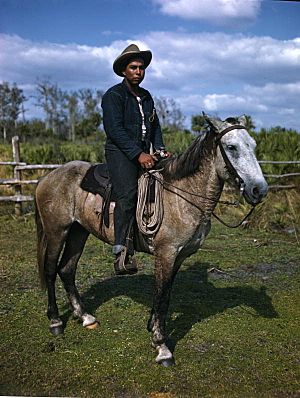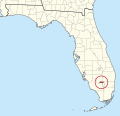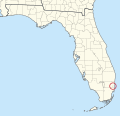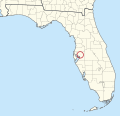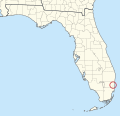Seminole Tribe of Florida facts for kids
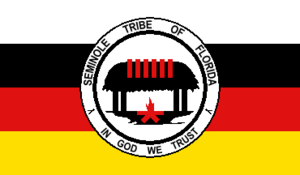 |
|
| Total population | |
|---|---|
| 4,244 enrolled members (in 2019) | |
| Regions with significant populations | |
| Languages | |
| English, Spanish, Miccosukee, Creek | |
| Religion | |
| traditional Seminole religion, Christianity | |
| Related ethnic groups | |
| Seminole Nation of Oklahoma, Miccosukee, Muscogee people (Creek) |
The Seminole Tribe of Florida is a Native American tribe that the United States government officially recognizes. They live in the state of Florida. This tribe is one of three main Seminole groups that the U.S. government recognizes. The others are the Seminole Nation of Oklahoma and the Miccosukee Tribe of Indians of Florida. The Seminole Tribe of Florida gained this official status in 1957. Today, they have six special areas of land called reservations in Florida.
In 1975, the Tribe started businesses like tax-free shops and a big bingo game. This bingo game was one of the first times a Native American tribe ran a gambling business in the U.S. These businesses, especially the gaming, have made a lot of money for the tribe. This money helps pay for education, support for tribal members, and new business projects. In 2005, the tribe earned about $1.1 billion from these activities. To be a member of the tribe, a person must have at least one-quarter Seminole ancestry.
Contents
- The Seminole Story: How the Tribe Began
- Building a Stronger Tribe: How They Organized
- How the Tribe is Led: Governance and Leaders
- Growing the Economy: Tribal Businesses
- Who Can Be a Member?
- Seminole Reservations: Where They Live
- Language: How the Seminole Communicate
- Culture: Traditions and Celebrations
- Florida State University: A Special Connection
- Tribal Chairmen Since Reorganization
- Important Florida Seminole People
The Seminole Story: How the Tribe Began
The Seminole people came together from different Native American groups in Florida during the 1700s. Many of them were Creeks from areas that are now northern Florida, Georgia, and Alabama. They slowly became different from other Creek groups. The Seminole grew and became successful because they had a strong trade network. This happened during the times when Florida was ruled by the British and later by the Spanish (from about 1767 to 1821). These new settlers also joined with the few Native Americans who had survived from ancient Florida tribes.
During this time, the Native American villages were mostly independent. They also formed friendships with African-American maroons. These maroons were mostly people who had escaped slavery from the southern states. Some were also free Black people from the Spanish rule period. These people became known as Black Seminoles. They built their towns close to the Native American settlements.
Life in the Everglades: Staying in Florida
In the 1800s, the Seminole fought against the United States in wars called the Seminole Wars. After the second war, the U.S. government forced most Seminole and Black Seminoles to move west of the Mississippi River to a place called Indian Territory. However, a smaller group, maybe fewer than 500 people, refused to leave Florida. They moved deep into the Everglades. There, they avoided settlers and lived well, mostly on their own. They became very strong and independent. The modern Seminole people in Florida, the Miccosukee, and other traditional groups are descendants of these brave survivors.
The Florida Seminole slowly started to connect with the United States and Florida governments again in the late 1800s. By the early 1900s, they mostly lived in five camps in the Everglades. The group who spoke more of the Muskogee language gathered in the northern Everglades. They became known as the Cow Creek Seminole. The Miccosukee, who spoke the Mikasuki language, lived further south. Their area was changed when the Tamiami Trail road was finished in 1928.
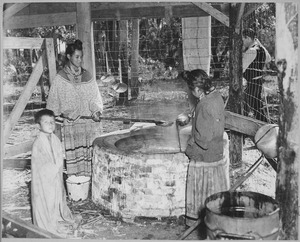
The Cow Creek Seminole eventually received about 5,000 acres (20 km²) of reservation land in the 1930s. The first was the Brighton Reservation. At first, many Seminoles did not want to move to reservations. They preferred their traditional way of life. But after Christian missionaries from the Creek tribe helped, more Seminoles moved to reservations in the 1940s to start their own churches. Other reasons for the move included Florida draining the wetlands and starting large farms. This meant less wild game and other resources for the tribe. It became harder for them to live in their traditional ways.
Building a Stronger Tribe: How They Organized
Between the 1920s and 1940s, the Everglades, where the Seminole lived, changed a lot. Settlers and developers wanted to turn wetlands into farms and homes. They built drainage projects that changed the Everglades ecosystem and harmed many animals. As early as 1916, a conservation area was set aside. This area later became part of the Everglades National Park in 1947. Building the Tamiami Trail across the Everglades and other projects caused many Seminole families to move from their homes.
In the 1930s, the U.S. government set up a reservation at Brighton. They tried to get Seminoles to move there. The government fenced the reservation and brought in cattle. Raising cattle had been a part of Seminole culture for 300 years. The first cattle arrived in 1934. By the late 1930s, raising cattle became a way of life for many Seminole people.
Working with Cattle: New Ways to Lead
When cattle farming started at Brighton, the Seminoles learned about democratic ideas and how to organize their tribe. The government required the tribe to elect three leaders to manage the cattle program. The first election was guided by a government agent and a missionary. They chose men who spoke English and worked well with white people. This was different from letting the tribe choose the best cattle farmers.
Because the cattle program was successful at Brighton, the Seminole bought 150 cattle for the Big Cypress Reservation in 1941. By 1944, the Big Cypress Seminole wanted their own leaders for the cattle program. They made an agreement with the government. This agreement created two cattle businesses, one for Brighton and one for Big Cypress. Each would have three elected leaders. These leaders would also represent the tribe. This helped choose people who could work well with both Native American and white communities.
Even though this tribal organization was new and not very strong at first, the tribe used it. They decided to file a claim with the Indian Claims Commission. They wanted money for the lands the U.S. government had taken from them.
Claiming Their Land: A Long Fight
In 1948, the cattle associations met with a government official to talk about making a land claim. They hired a lawyer named Roger J. Waybright. He agreed to help them. The claim was officially filed on August 14, 1950. It asked for money for land taken in several treaties from 1823 to 1839. It also included land taken in 1944 for the Everglades National Park. The total amount was almost $48 million.
The Seminole Nation of Oklahoma also filed a similar claim. Because the claims overlapped, the commission split the Florida claim into two parts. One part was shared with Oklahoma, and the other was only for Florida's land in the Everglades.
The land claim process took a very long time. There were government delays, changes in tribal organization, and lawyers leaving the case. Finally, in 1970, the Claims Commission awarded $12,262,780. Both the Oklahoma and Florida Seminoles disagreed with this amount. In 1975, to avoid more delays, they agreed to a final settlement of $16,000,000. They had to get their tribes to agree to this amount.
In 1976, the Florida Seminole were told about the settlement terms. It was translated into both the Mikasuki language and Muscogee language. Only seven tribal members did not want to accept the agreement. It took another fourteen years for the money to be given out. The commission did not say how the money should be split between the Oklahoma and Florida Seminoles, the Miccosukee, and other traditional groups.
The different groups had to talk and decide how to share the money. This was the most they had talked in 100 years. The money was held in a special account and earned interest. By 1990, the total amount was $46 million. They finally agreed that the Seminole Nation of Oklahoma would get three-quarters of the money. The Florida Seminole groups would get one-quarter.
Facing Challenges: Threats to Their Status
In 1953, the Seminole learned that the government might end their official tribal status and federal benefits. This was part of a plan to save money. But ending their status would mean they would lose their reservations. Few Seminoles at that time had finished high school, and they worried about managing their own affairs.
The government considered all 918 Native Americans in Florida as Seminole. However, the 305 Miccosukee and other traditional groups did not see themselves as part of the reservation Seminole. They had been independent since the 1920s. The Seminole asked for federal help to continue so they could prepare to manage their own affairs.
The government asked tribal leaders to choose representatives for hearings. They chose people from different reservations and also from the "Trail people" (those living off reservations). They also had interpreters for the Creek and Mikasuki languages. Even though the traditional groups wanted to keep their old Tribal Council, the Seminole kept working on a new government.
They went to Washington, D.C., to speak to Congress. They also asked for help from women's groups who supported the Seminole. These groups helped children go to boarding schools and lobbied for Seminole children to attend local public schools. They also loaned money to men who wanted to buy homes.
The Seminole talked with other tribes and experts to help them create their government. They wrote a constitution and a corporate charter, which is like a set of rules for how they would run things. In 1957, the 448 reservation Seminole and any Trail Indians who wanted to participate voted. They approved the constitution on August 21, 1957. The Seminole Tribe of Florida then received official federal recognition later that year.
This process showed the differences between the groups. The Trail people, who spoke Mikasuki, formed their own government. They were recognized by Florida in 1957 and by the federal government as the Miccosukee Tribe of Indians of Florida in 1962. Some traditional groups chose not to join either tribe, as they wanted to avoid working with the federal government. The Miccosukee also received reservation land. In 1983, both tribes made a long-term agreement with Florida to use almost 200,000 acres (809 km²) of wetlands. This helped them continue their traditional fishing and hunting.
How the Tribe is Led: Governance and Leaders
The Seminole Tribe of Florida is led by an elected tribal council. This council has representatives from each of its reservations. The tribe also elects a chairman and a vice-chairman as their main leaders. The main offices for the tribe are in Hollywood, Florida.
Important Leaders of the Tribe
In 1975, Howard Tommie was re-elected as chairman. He led the Tribe until 1979. During his time, he started important projects that changed the tribe's future. He pushed for the tribe to have more control over its own affairs. He also helped create ways to make a lot of money and grow the tribe's economy. He encouraged the tribe to accept the U.S. land claims settlement in 1976. He also started talks with Florida about water rights for the Seminole reservations. This helped protect their resources.
Jim Billie was re-elected in 2011. He had served as chairman before, from 1979 to 2001. He led the tribe through a huge growth in its businesses. The tribe used the money from gaming and entertainment to build new programs and facilities. He was later removed from his position in 2016.
Growing the Economy: Tribal Businesses
Chairman Tommie learned from other tribes and started a tax-free cigarette shop on the Hollywood Seminole Indian Reservation. This helped the tribe earn more money. Next, they started a big bingo game on their reservation, which also brought in a lot of money.
Gaming, Hotels, and More
Jim Billie continued the tribe's plan for high-stakes bingo in 1979. Even after many court challenges, the first major Indian gaming business in the United States opened in 1981, run by the Seminole. Later, changes in laws allowed many other tribes to earn money from gambling casinos, resorts, hotels, and shops. These businesses also bring money to the states where they are located.
The Seminole tribe has seven casinos. In 2007, the Tribe bought the Hard Rock Cafe company for $965 million. This included 124 Hard Rock Cafes, hotels, and concert venues. Since then, they have used the Hard Rock brand in their own hotels and casinos.
Online Sports Betting
In 2021, Florida Governor Ron DeSantis made a deal with the tribe to offer online sports betting. However, a judge later said this deal broke federal law. The judge said that gambling must happen on tribal lands, unless state law allows online betting from anywhere in the state. Since Florida law did not allow this, the agreement was canceled.
The tribe appealed the ruling, but the appeal was denied. The Department of Justice also appealed.
Other Important Businesses
Other important parts of the Seminole economy are growing citrus fruits and raising cattle on the Brighton and Big Cypress reservations. They also work in forestry. The Seminole Tribe started with a small group of cattle in the 1930s. Now, they have the 12th-largest cattle business in the country. It is mainly on the Big Cypress and Brighton reservations. Since 2008, the Seminole Tribe has sold its beef under the name Seminole Beef. They use it in their Hard Rock Cafe and hotels. They also plan to sell it to other Native American tribes, military bases, restaurants, and supermarkets.
Tourism is also a big part of their economy. This includes people visiting their casinos and coming to the reservations for hunting, fishing, and guided tours.
Money and Jobs
In 2005, the tribe earned $1.1 billion in revenue. They give a share of this money to tribal members every month. In 2012, the Tampa Bay Times newspaper reported that the Seminole Tribe employed 12,000 people at its main office and six casinos.
Who Can Be a Member?
In the early 1900s, most Seminole people were full-blooded. They also had rules against marrying people from outside the tribe. In 1999, Betty Mae Tiger Jumper, who was a chairwoman of the Tribe, said that in the late 1920s, some Seminole medicine men threatened to kill her and her brother. This was because they had a white father. She learned that other children with mixed heritage had been killed. Her great uncle moved her family to the Dania reservation to keep them safe.
Similarly, former chairman Jim Billie, who also had a white father, said that in 1944, when he was a baby, tribal men threatened him because he was mixed-race. His mother and Betty Mae Tiger saved his life.
The tribe is now more open to people marrying outside the tribe. They also allow non-tribal spouses (including white or Black people) to live on the reservations, which was not allowed before. To be a tribal member, a person must have at least one-quarter Seminole ancestry.
In 2000, there were about 2,000 enrolled members in the tribe. Over 1,300 of them lived on the reservations. The Tribe includes some Black Seminoles, with 50 living on the Fort Pierce Reservation.
Seminole Reservations: Where They Live
The Seminole Tribe currently has six reservations:
- Big Cypress Reservation: This is the largest area, covering about 82 square miles (212 km²).
- Brighton Reservation: This area is about 57 square miles (148 km²).
- Hollywood Reservation: This reservation is about 497 acres (2 km²).
- Immokalee Reservation: Located in Immokalee, Collier County.
- Tampa Reservation: Located in Hillsborough County.
- Fort Pierce Reservation: A 50-acre (0.2 km²) site in St. Lucie County. The tribe built modern homes and a community center here.
The tribe also bought 796 acres (3.2 km²) of land near Lakeland, Florida. They plan to build 151 homes and facilities for social, cultural, and educational needs there.
Language: How the Seminole Communicate
Most members of the Tribe speak two languages: the Mikasuki language and English. The Miccosukee Tribe also speaks Mikasuki. In the 1970s, everyone on the Big Cypress Reservation still spoke Mikasuki. Some Florida Seminole also speak the Creek language, especially those on the Brighton Reservation. However, fewer young people are speaking these traditional languages now.
Culture: Traditions and Celebrations
The Seminole people still follow traditional practices, like the Green Corn Dance. They have two special ceremonial grounds inside the Big Cypress National Preserve.
They have also created new celebrations. One is the Big Shootout at Big Cypress, which has been celebrated since 1997. A few years ago, they added a historical re-enactment to this event. In it, people act out the roles of Seminole, Black Seminole, and U.S. forces.
In 1956, Betty Mae Tiger Jumper and Alice Osceola started the first tribal newspaper, the Seminole News. It cost 10 cents a copy. It stopped for a while, but in 1972, the Alligator Times was started. In 1982, it was renamed the Seminole Tribune, and it is still published today. Betty Mae Tiger Jumper became its editor. She shared traditional stories and articles about Seminole culture. In 1989, the Seminole Tribune was the first Native American newspaper to win a Robert F. Kennedy Journalism Award. It was also nominated for a Pulitzer Prize that year.
The Seminole tribal libraries include the Billy Osceola Memorial Library in Brighton, the Willie Frank Memorial Library in Big Cypress, the Dorothy Scott Osceola Memorial Library in Hollywood, and the Diane Yzaguirre Memorial Library in Immokalee. These libraries are open to the public. They focus on materials about the Seminole Tribe and Florida. The libraries have over 23,000 books, magazines, videos, photos, and tapes. They also have an archive of news articles about the Seminole Tribe, including the Seminole Tribune. More than 20,000 people visit the libraries each year, and they offer summer programs. Both tribal and non-tribal people use the libraries for research.
The idea for a Tribal Library started in the 1940s at the Brighton Day School. In 1985, the system was improved. A professional librarian was hired, and the libraries were updated. Recently, the libraries have become more modern. Their card catalogs are now automated, and they have an Electric Library where people can view thousands of books, magazines, and radio and TV transcripts online.
Florida State University: A Special Connection
Florida State University (FSU) in Tallahassee uses the Seminole name and images for its sports teams, called the Florida State Seminoles. The name was chosen in 1947 after fans voted. Since 1978, a student dressed as Osceola has been the official symbol at football games.
In the 1980s and 1990s, some people thought that sports mascots based on Native Americans were disrespectful. Many Native Americans and their supporters protested against them. Florida State talked with the Seminole Tribe of Florida. FSU explained that they used the names and Osceola to honor the tribe, not to be disrespectful. Several Seminole Tribe leaders, including Chairman James E. Billie and Council Member Max Osceola, have approved FSU's use of Seminole images. However, some other Florida Seminoles and members of the Seminole Nation of Oklahoma still have concerns.
In 2005, FSU was one of the schools that might have faced penalties from the NCAA for using Native American mascots. But after much discussion, the NCAA allowed FSU to continue. They said FSU's good relationship with the Seminole Tribe of Florida was a big reason for this decision. Today, both FSU and the Tribe publicly praise their good relationship.
Florida State University does not see the Seminoles as just a mascot. Instead, they admire the Seminole's history of being unconquered. FSU honors the traditions of the Seminole tribe. Tribal members are present at FSU's homecoming celebration. They crown the new homecoming king and queen with real, handmade items from the tribe. FSU also offers a scholarship program specifically for members of the Seminole Tribe.
In 1993, Shayne Osceola became the first member of the Seminole tribe to graduate from FSU.
Tribal Chairmen Since Reorganization
- 1957–1966: Billy Osceola, the first chairman.
- 1967–1971: Betty Mae Tiger Jumper, the first and only chairwoman of the tribe. She was also an editor and storyteller.
- 1971–1979: Howard Tommie, a political leader who started important programs. He helped the tribe accept the land claim settlement and set up successful businesses like tax-free shops and bingo.
- 1979–2003: Jim Billie, led the tribe during a time of big growth in Indian gaming and tribal wealth. He was removed from his position in 2003.
- 2003–2011: Mitchell Cypress.
- 2011–2016: Jim Billie, re-elected but later removed from his position by the Tribal Council.
- 2016–present: Marcellus Osceola Jr.
Important Florida Seminole People
- Abiaka: A "medicine chief" and war chief during the Seminole Wars. He successfully resisted efforts to remove Native tribes from the Southeastern United States.
- Jim Billie: The longest-serving chairman of the tribe.
- Louise Gopher: The first Seminole Tribe of Florida member to graduate from college.
- Betty Mae Tiger Jumper: The first female chief.
- Cheyenne Kippenberger: The first Seminole woman to be crowned Miss Indian World.
- Micanopy: A main chief from 1825 through the Second Seminole War.
- Osceola: Born William Powell Jr., a war chief during the Seminole Wars.
- Jim Shore: The first Florida Seminole to become a lawyer. He played a big role in land claims talks.
- Susie Jim Billie: A traditional medicine maker and important elder of the Panther clan.


